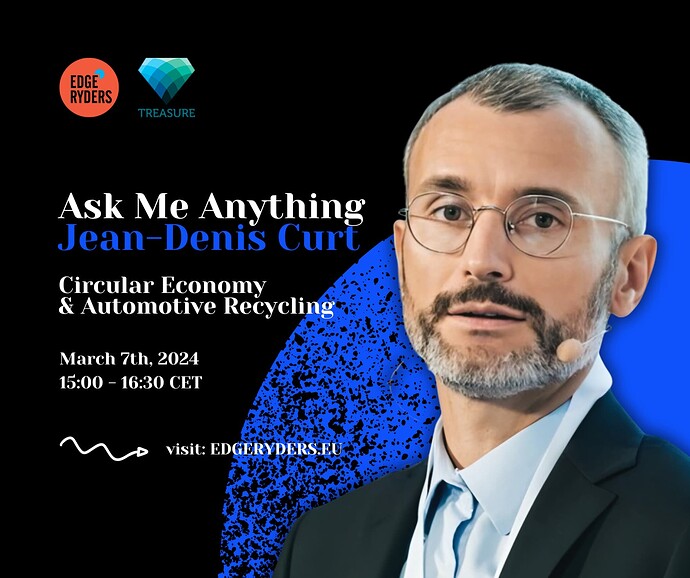Join Our Exclusive Ask Me Anything Session with Jean-Denis Curt on Circular Economy & Automotive Recycling
Date & Time: March 7th, 2024 | 15:00 - 16:30 CET
Location: Online Event (register here)
The automotive sector stands at a pivotal juncture, facing the dual challenges of rapid technological evolution and increasing environmental pressures. As the industry moves towards more sustainable practices, understanding the role of circular economy becomes paramount.
We are excited to announce an Ask Me Anything (AMA) session with Jean-Denis Curt, a leading figure in Circular Economy, Strategic Materials, and Life Cycle Assessment (LCA) at Renault Group. With extensive expertise in the field, Jean-Denis will offer invaluable insights into the challenges and opportunities of material recycling within the automotive industry, focusing on the potential of old vehicles as valuable resources and innovative approaches to recycling electric vehicle batteries.
This exclusive event, hosted by Edgeryders in the framework of the TREASURE project, offers an unparalleled opportunity to engage with Jean-Denis Curt on the pressing issues and exciting opportunities in automotive recycling and sustainability.
This event is a must-attend for:
-
Automotive Professionals looking to integrate sustainable practices into their operations.
-
Sustainability Advocates keen on understanding circular economy applications in the automotive industry.
-
Curious Minds interested in the future directions of automotive technology and environmental impact mitigation.
Event Highlights:
- Introduction by Edgeryders: Setting the stage for an insightful discussion.
- Expert Presentation: A 30-minute deep dive into key topics by Jean-Denis Curt, shedding light on the intricacies of sustainable practices in the automotive sector.
- Interactive Q&A Session: Spanning 30 to 60 minutes, this segment offers you the chance to ask Jean-Denis your burning questions and explore further into the subject matter.
Registration:
Don’t miss out on this opportunity to engage with an industry expert. Please register here to secure your spot.
Prepare for the Event:
We invite you to come prepared with your questions to make the most out of this session. Help us tailor the discussion to your interests by answering these questions.
About Treasure
TREASURE (leading the TRansion of the European Automotive SUpply chain towards a circulaR futurE) is a 3-year- Research and Innovation Action co-funded by the European Commission under the H2020 programme willing to offer new opportunities for testing innovative technologies to make the automotive sector more circular. Within Treasure, Edgeryders is creating a community-driven model of addressing social aspects related with circular design practices. We want to develop new knowledge on how circular economy plays out in society, economy and everyday life, the points of view of the people directly affected by circular economy.
This project has received funding from the European Union’s Horizon 2020 research and innovation programme under grant agreement No 101003587

